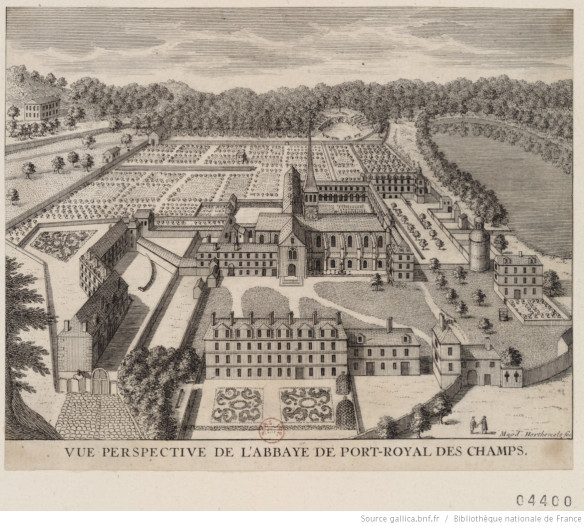
-Abbess Angelique Arnauld, S.O.Cist., (1591-1661), a champion of the heresy of Jansenism. Please click on the image for greater detail.

-plan of Port-Royal-des-Champs, after an engraving by Louise-Magdeleine Horthemels, c. 1710, please click on the image for greater detail.
“…The epicenter of Jansenism was the convent of Port-Royal des Champs (outside Paris), a formally lax establishment, which had been overhauled by the formidable abbess Angélique Arnauld (1591–1661).[1] Mére Angélique was serious about reform, because she had imbibed the rigorist Christocentric renewal currents coming from the circles of Pierre de Bérulle (1575–1629), and two men she knew personally: François de Sales (1567–1622) and the Abbé Saint-Cyran (1581–1643). The latter, a very close friend of Jansen, eventually became the spiritual godfather of the nuns of Port-Royal… [Ed. The scientist and philosopher Blaise Pascal (1623–62) was a convert to the early Jansenist cause.]
…Closely connected with the Jansenist desire to defend the “truth” about grace and predestination in the face of Jesuit “novelty” was their concern for protecting the Eucharist from profanation. It was this debate that gained a great deal of popular attention and thrust Pascal into the spotlight. The pastoral (or lax) opinion championed by many Jesuits was that attrition was sufficient for absolution in the confessional—that is, one needed only to seek forgiveness because one feared divine wrath.
The rigorist position, which Jansenists argued was the practice of the Early Church and sufficiently clear in patristic sources, was that only contrition—that is, love of God and sorrow for having offended him—sufficed for absolution. This debate sparked Pascal’s famous Provincial Letters, which ridiculed the lengths to which Jesuitical “casuistry” would go to lessen the weight of sin or excuse it entirely. Pascal’s brilliantly entertaining satirical letters might have been unfair to the many good and devoted Jesuit pastors, but they certainly described some real problems in French society…
…King Louis XIV [decided]to act decisively. The divine-right monarch had never liked Jansenists. They stank of a stubborn individualism, a spirit of inquiry, and a questioning of his absolutism. It was especially irksome that a group of women (the indomitable nuns of Port-Royal) continued to defy not only successive archbishops in Paris and popes in Rome, but even the Sun King in Versailles.
Louis XIV had had enough of this, and he finally demolished Port-Royal (literally) in 1711, and scattered the surviving sisters into different houses…Nevertheless, the women of Port-Royal were exemplars of female Catholic bravery and scholarship; these learned and devout women tenaciously asserted their right to read scripture and the Church Fathers and participate in theological debates.[5]”

-nuns being forcibly removed from Port-Royal des Champs abbey, please click on the image for greater detail.

-a solitary surviving chapel from Port-Royal des Champs abbey, and Mere Angelique’s tomb, amid the ruins of Porty-Royal des Champs abbey.

-by Fr Christopher Pietraszko, is a priest in the Roman Catholic Diocese of London, Ontario, Canada
“There is a close connection between cancel-culture and the heresy of Jansenism. Jansenism’s error was to myopically assess the work of grace, and perhaps over-simplify it. As a result grace was seen as to not abound, or to be extended to all people sufficiently. As a result, a Puritan-like attitude arose, where if something was corrupt, the whole thing would be thrown out. Any slight imperfection meant the whole thing was abject and worthy of condemnation.
Looking upon the past with a cavalier attitude will only come back to haunt ourselves as the next generation sees our own blindness, and throws us into the same gutter.
Recognizing that the world is corrupted is honest. Throwing it away is reckless. Why? Because of a very sound doctrine that teaches us that evil is always adhering to something good, and by uprooting the evil, we also uproot the good. Christ Himself taught us this with the parable of the weeds and the grain. The middle way is to seek to redeem what is broken, to heal what is wounded, to distinguish carefully and diligently between what is unjust and what is just.
This tendency towards Jansenism is not only seen in secular society, but I’ve observed it as well within attitudes towards canceling the Novus Ordo, or the TLM, or the Pope, or the Bishops, or adhering to sacred obedience. It’s a sneaky trap that transcends all political categories and seeks to uproot the good with the bad. It doesn’t enjoy the hard work of discernment, and flippantly and in an often fraudulent (fallacious) way, doesn’t distinguish between the good and the evil. It reacts and throws the whole thing out.
If there was ever a heresy so close to Calvin’s “total depravity” this is it. God teaches to do something different. He wants what is dysfunctional and imperfect to enter a process of sanctification. He builds off what is already good, to undermine the ravages of what is already evil. He does not flip a switch of grace and make one perfect in an instant, but rather slowly unfolds a path before us that saved, is saving, and will save us.”
Love, His grace, His transformation, His sanctification of us, was, is, will be,
Matthew
[1] F. Ellen Weaver, The Evolution of the Reform of Port Royal: From the Rule of Cîteaux to Jansenism (Paris: Beauchesne, 1978); Louis Cognet, La Réforme de Port Royal (Paris: Sulliver, 1950).
[5] Among many excellent studies see Daniella Kostroun, Feminism, Absolutism, and Jansenism: Louis XIV and the Port-Royal Nuns (Cambridge: CUP, 2011); John J. Conley, SJ, The Other Pascals: The Philosophy of Jacqueline Pascal, Gilberte Pascal Périer, and Marguerite Périer (South Bend, IN: Notre Dame, 2019).


